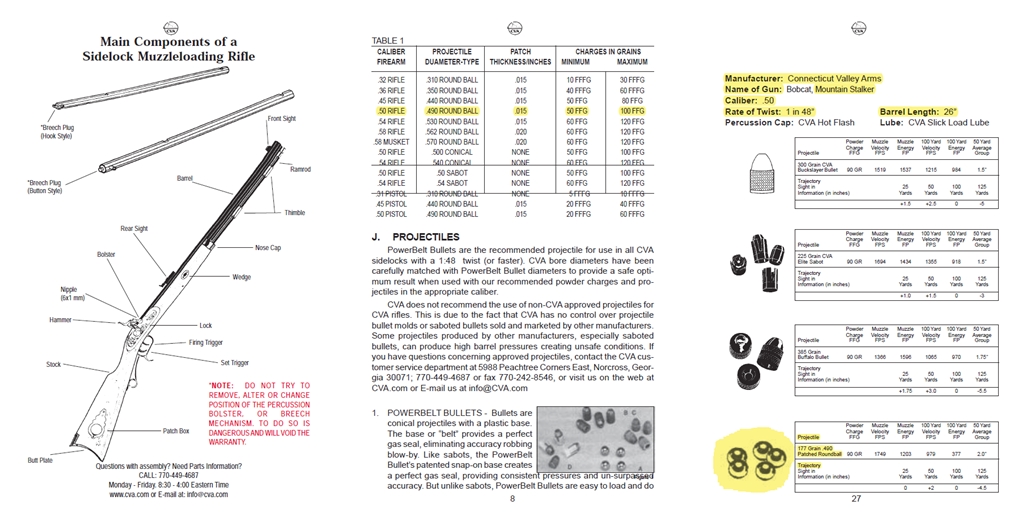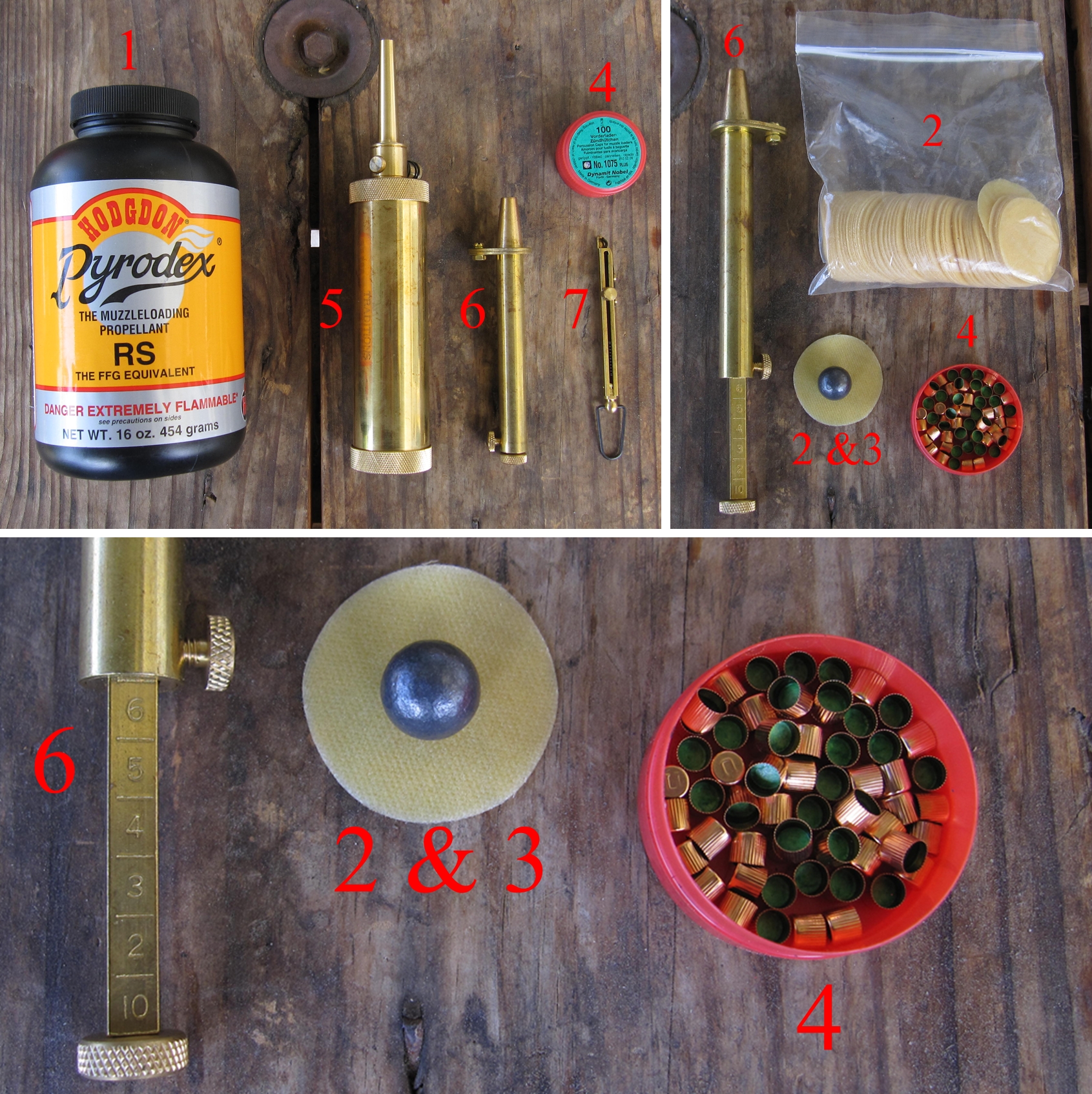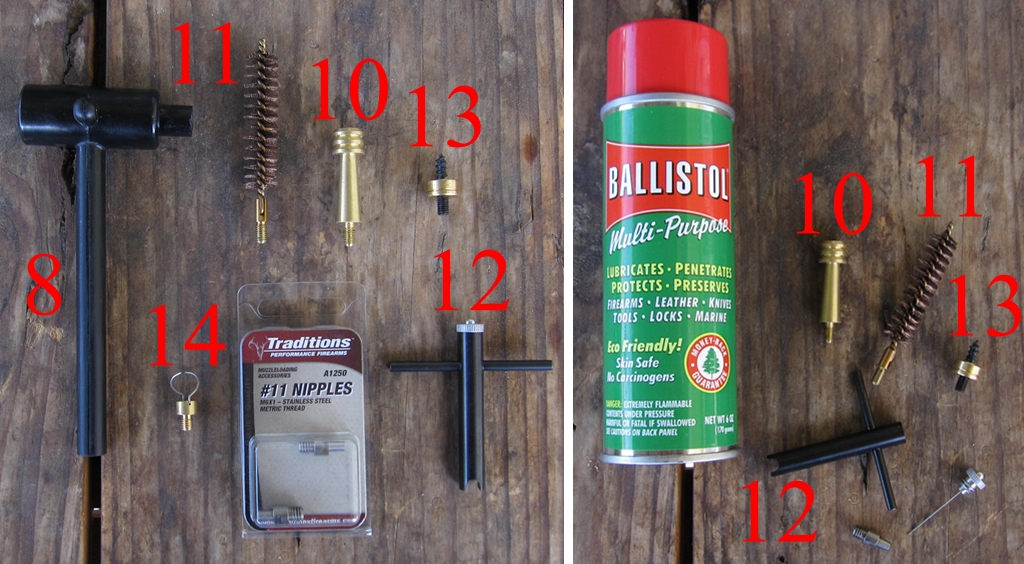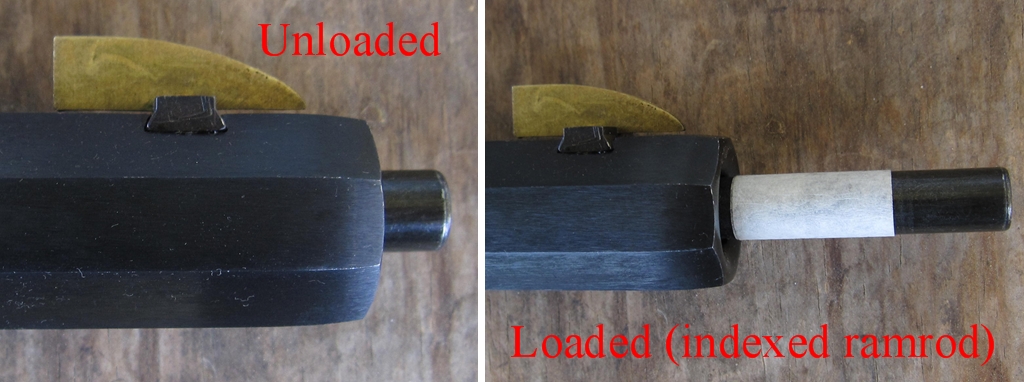
- The good, the bad and the ugly of black powder muzzleloading 101 with featured guest El Feo (The Ugly).
- 210325, OAUSA BP Rifle 01a.jpg (274.91 KiB) Viewed 640 times
Muzzleloading 101 for The Beginner: Focusing on traditional side-lock percussion rifle shooting. We'll try to make it as comprehensive as possible but I am coming at this as a novice and it will help for many to weigh-in and provide both the good, the bad and ugly of collective black powder shooting. We'll cover some of the basics below:
- Open for Q & A outside of side-lock black powder
Gearing up for the sport and some tenets that are good to know and practice that will come in handy throughout the discussion. Here is a suggested list and photo of items it would be nice to have when starting out before you figure out you might want to get more involved or keep this as a "nice to know" skill.
Form of muzzleloader:
o Rifle
- Side lock in either flintlock or percussion cap
o Pistol (see above)
o Revolver (a cylinder that provided up to 6 shots)
o Shotgun (both single and double barrel)
There are some advantages and disadvantages of each style of muzzleloader. Quickly and very succinctly: Traditional flintlock & percussion arms are subject to "ignition" issues and this is something inherent in the way the powder charge for the round is initiated by either flash pan powder or the percussion cap. But they are really very similar to modern smokeless powder firearms in that the main ingredients to get this bullet to move down the barrel come from the ignition source, the powder and the projectile; a concept that continues to this day. Black powder cartridges with relatively low pressures and heavy projectiles kept the manufacturing process less technical and even with the invention of cartridges that housed the primer, powder and projectile in a ready to use boxer primed modern day cartridge, the firearm world did not see the advances we recognize today until the use of smokeless powders.
Starting out with El Feo (Spanish for The Ugly), I purchased the following equipment to get started and it worked out really well so far:
Rifle: El Feo, CVA, side-lock, black powder, percussion rifle, 26" barrel with a 1:48" twist (and owner's manual).

- The Owner's Manual is the recommended source for your first outing and preparation. In this case it was a very small manual and it had a lot of information along with YouTube University that provided a great place to start. I also had help from seasoned BP shooters that filled in all my questions satisfactorily. In my case a simple PDF search on the internet got the owner's manual on my desk top in about 2 minutes.
- 210325, OAUSA BP Rifle 02.jpg (310.76 KiB) Viewed 641 times

- The numbers correspond to the component numbers described below.
- 210325, OAUSA BP Rifle 05a.jpg (2 MiB) Viewed 640 times
Load (things that go boom; in order of use):
1. Black Powder Substitute; Pyrodex RS (rifle/shotgun powder)
2. Lubed Patches, .015"
3. Round ball, .490, 176 grain for the .50 caliber rifle
4. Primers, #11

- The numbers correspond to the component numbers described below.
Ballistol: A quick product spotlight with respect to muzzleloading and firearms in general. - 210325, OAUSA BP Rifle 06a.jpg (504.44 KiB) Viewed 638 times
Ballistol cleans and removes all types of bore fouling. Cleaning with Ballistol will save you time, minimize the need for brushing, and also form a protective film on your firearm. Due to its slight alkalinity, Ballistol neutralizes and dissolves black powder and corrosive ammo residue. In addition, Ballistol will beautify gunstocks, and prevent them from drying out. As a lubricant, Ballistol will never gum up or harden. With Ballistol, your entire firearm will stay lubricated and protected. To read more, visit their website here:
https://ballistol.com/
Miscellaneous but necessary and good to have:
5. Powder flask, powder horn or dipper that dispenses powder
6. Powder measure (with funnel set @ 60 grains)
7. Capper
8. Bullet Starter
9. Ramrod
10. Jag
11. Bore brush
12. Nipple Wrench w/Nipple Pick or "Pricker"
13. Bullet Extractor/Ball Screw
14. Patch Extractor
Miscellaneous that should be considered (will not hinder future sessions but it is something to consider):
* Possibles Bag (the "got everything you need man purse")
* Breach Plug Grease
* Dedicated ramrod
* Patch Cutter
* Funnel (powder to flask/horn and powder from measure to barrel)
* CO2 Discharger

- This is a recommend technique for insuring you have both a visual and tactile way of knowing whether you have no load, a single load or you have the potential for a barrel obstruction or double load in the barrel (see item 1. below; insure rifle is unloaded).
- 210325, OAUSA BP Rifle 09a.jpg (297.15 KiB) Viewed 633 times
GETTING STARTED
1. Safety First - Verify gun is unloaded
2. Assemble gun. CAUTION: If you sell, trade or give this gun (or kit) to another person, make sure you give the new owner a copy of this manual or advise him to get a copy from CVA.
3. Check all functions
4. Remove nipple
5. Clean barrel
6. Replace and tighten nipple until snug
7. Read and study information booklet
8. Understand terminology
9. Get all questions answered
TEN COMMANDMENTS OF FIREARM SAFETY
1. Keep the gun muzzle pointed in a safe direction
2. Be sure of your target and beyond
3. Never rely on a gun’s safety
4. Gun should be unloaded until ready to use
5. Always wear eye and ear protection
6. The barrel should be clear of obstruction before shooting
7. Handle every gun as if it is loaded
8. Keep guns and ammo separate and in locked storage
9. Avoid alcoholic beverages and drugs before and during using a firearm
10. Do not alter or modify your firearm. Have your firearm checked regularly by a competent gunsmith. Make sure all parts work properly.
SAFETY CONSIDERATIONS UNIQUE TO MUZZLELOADERS
1. Never smoke when shooting or handling a muzzleloader or related equipment. Ashes and/or loose sparks may cause powder or caps to ignite, resulting in personal injury or death
2. Always wear eye protection. Flying debris from the breech area is always a possibility with any muzzleloader.
3. Never pour powder into a muzzleloader directly from a flask, horn or any large volume, enclosed container. Hot embers in the barrel could cause the container to explode
4. All powder storage containers and percussion caps should be kept well away from the area where shooting is to be conducted. Sparks from shooting could cause accidental ignition of these devices. Follow all manufacturers instructions for long term storage of powder and percussion caps.
5. Use only blackpowder, Pyrodex, Pyrodex Pellets (in approved rifles only), or other approved blackpowder substitutes in muzzleloading firearms. Never use modern smokeless powder in a muzzleloader. The use of any amount of smokeless powder in a muzzleloader will create dangerously high pressures upon ignition and may result in severe injury or death to the shooter and/or bystanders.
What not to do (don't try this at home):
https://www.youtube.com/watch?v=vUUnDeVXD3M
6. Always check to ensure that your muzzleloader is in good working condition before use. Test the hammer and lock mechanisms carefully prior to loading. Check the barrel for any obstruction as any blockage may cause the gun to explode.
7. Use only recommended loading data for the particular model of rifle in use. Different models have different powder charge and projectile capabilities. Improper loading or overloading of a muzzleloading firearm may result in severe injury or death.
8. Never place a cap on the firearm until you are ready to fire. Cap should always be removed when walking, climbing trees or fences, transferring the gun from one person to another, leaving the gun unattended, etc.
9. Never lean or rest a loaded muzzleloader against a tree, wall, vehicle or other surface. Any fall of the loaded gun may cause accidental discharge resulting in severe injury or death to bystanders.
10. Never transport a loaded muzzleloader in any type of vehicle. A muzzleloader is considered loaded until powder, bullet and percussion cap are removed.
11. Never exchange a loaded muzzleloader with any other person. Only the party who personally loaded or witnessed the loading of the muzzleloader should fire it. This practice will help prevent overloading or doubleloading, which may cause severe injury or death.
12. Never store a loaded muzzleloader. Muzzleloaders should be unloaded and cleaned prior to any storage.
13. Never load a muzzleloader without first making sure that it is unloaded.
14. Exercise extreme caution when hunting from treestands with muzzleloaders. The dropping of a loaded muzzleloader may cause accidental discharge leading to severe injury or death. Be sure the cap is removed whenever raising or lowering the firearm.
15. Never allow the hammer of a muzzleloader to rest against the cap. Any impact to the hammer or bolt could cause accidental discharge.
16. Never rely upon the “half 000” position as a safety. Muzzleloaders should always be handled as if ready to fire, regardless of the safety systems employed
17. Always use proper cleaning procedures. Firing improperly maintained muzzleloaders may lead to unsafe pressure conditions, resulting in severe injury or death
18. Make sure that the projectile is firmly seated against the powder charge. “Short starting” of the projectile may cause the gun to explode.
19. Always keep the muzzle of the gun pointed in a safe direction while loading. Never lean over the muzzle while loading.
SPECIFIC CAUTIONS FOR SAFE USE OF CVA SIDELOCK MUZZLELOADING FIREARMS
- YOU ARE RESPONSIBLE FOR FIREARM SAFETY. As a gun owner, you accept a set of demanding responsibilities. How seriously you take these
responsibilities can mean the difference between life and death. There is no excuse for careless or abusive handling of any firearm. At all times handle your muzzleloader with intense respect for its firepower and potential danger.
- Seek professional instruction to become familiar with muzzleloading firearms. Qualified organizations such as local gun clubs, the National Rifle Association, the National Muzzleloading Rifle Association, and state hunter education programs offer approved courses which teach safe handling and hunting procedures. Muzzleloading firearms are different in function and safety features from modern firearms. Because of these differences, exercise caution and skill in the use of muzzleloading guns. Read and understand the functions and terminology explained in this book before attempting to use your CVA muzzleloader.
1. When selecting powder loads be sure to use the correct loading data for your particular model. CVA sidelocks are not designed to fire “magnum” loads.
2. Pyrodex Pellets are not recommended for use in CVA Sidelocks. This is due to the fact that #11 and Musket caps do not provide enough fire to consistently ignite the charge
3. Always follow recommended loading data when selecting bullet type and weight. Saboted bullets should not exceed 300 grains and conical lead bullets should never exceed 400 grains.
4. Never use oversized conical bullets in any CVA gun.
5. Never use modern smokeless powder, or any mix of smokeless powder, in CVA rifles. Such improper loading of the rifle may result in the explosion the gun, causing severe injury or death to the shooter and bystanders.
6. Never use “Poly Patch” in any CVA rifle.
Dangerous Muzzleloading Practices:
https://www.youtube.com/watch?v=gmsBF6CXs18&t=2s





